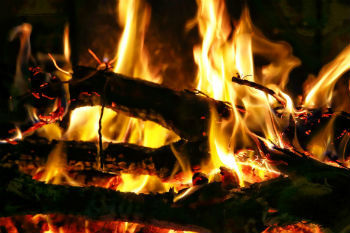Combustion is an exothermic chemical reaction between two conductors, fuel and oxidizer, in which energy is released in the form of heat.
- Fuel : It is the oxidizable substance, responsible for fueling combustion. Examples: gasoline, wood, cooking gas, alcohol and diesel.
- Oxidizing : It is the substance that intensifies combustion. In most cases, the oxidant is oxygen gas O 2 .
Combustion only occurs in the presence of fuel and oxidizer. Thus, it is only terminated or interrupted by the lack of one of these reagents.
Combustion is very common in everyday life, it is present in the burning of cooking gas, car fuels, candles, wood, paper, among others.

Types
Organic compounds have two types of combustion, complete and incomplete.
Complete combustion
Complete combustion is one that has enough oxygen to consume the fuel. It features CO 2 ( Carbon Dioxide ) and H 2 O (Water) as products.
The complete combustion presents greater heat release.
Examples :
a) Complete combustion of ethanol (C 2 H 6 O):
C 2 H 6 O + O 2 → CO 2 + H 2 O
When balancing the reaction:
C 2 H 6 O + 3 O 2 → 2 CO 2 + 3 H 2 O
In this reaction, the amount of oxygen was sufficient to consume all methanol and originate CO 2 and H 2 O as products .
b) Complete combustion of methane (CH 4 ):
CH 4 + O 2 → CO 2 + H 2 O
CH 4 + O 2 → CO 2 + 2 H 2 O
Incomplete Combustion
In incomplete combustion, there is not enough oxygen to completely consume the fuel.
It has two types of products: CO ( Carbon Monoxide ) or soot (C), substances that are toxic to the environment and harmful to health.
Incomplete combustion has less heat release.
Examples :
a) Incomplete combustion of ethanol:
C 2 H 6 O + 2 O 2 → 2 CO + 3 H 2 O = CO and H 2 O production.
C 2 H 6 O + O 2 → 2 C + 3 H 2 O = Soot production and H 2 O.
Note that between the two reactions there is a decrease in the amount of oxygen, which means less heat released.
b) Incomplete combustion of methane:
CH 4 + 3/2 O 2 → CO + 2 H 2 O
CH 4 + O 2 → C + 2 H 2 O
Combustion enthalpy
The enthalpy (H) of combustion or heat of combustion consists of the energy released in the burning of 1 mole of fuel, under standard state conditions (Temperature: 25 ° C; Pressure: 1 atm).
Because combustion is an exothermic reaction, the change in enthalpy (∆H) will always have a negative value.
The combustion enthalpy can be calculated using the following formula:
ΔH = H products – H reagents
Spontaneous combustion
Spontaneous combustion occurs without an external flammable source.
This happens with some materials capable of accumulating a lot of heat inside, increasing the speed of chemical reactions. This condition increases the temperature of the material until combustion occurs.
There is also evidence of spontaneous human combustion (CHE), in which the body burns without any influence from external sources.
The first record of this case would have happened to a woman, while she was sleeping, in 1663. Other similar cases were also related to spontaneous human combustion.
However, science still tries to understand how the process occurs in the human body. At the moment, there are only a few theories to explain the phenomenon.
